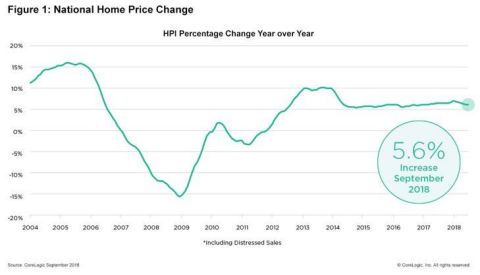- Younger millennials want to purchase a home, but affordability is a significant obstacle
- Nevada and Idaho were the only states to post double-digit annual price growth in September
- Home price growth projected to slow to 4.7 percent by September 2019
IRVINE, Calif. — (BUSINESS WIRE) — November 6, 2018 — CoreLogic® (NYSE: CLGX), a leading global property information, analytics and data-enabled solutions provider, today released the CoreLogic Home Price Index (HPI™) and HPI Forecast™ for September 2018, which shows home prices rose both year over year and month over month. Home prices increased nationally by 5.6 percent year over year from September 2017. On a month-over-month basis, prices increased by 0.4 percent in September 2018. ( August 2018 data was revised. Revisions with public records data are standard, and to ensure accuracy, CoreLogic incorporates the newly released public data to provide updated results each month.)
This press release features multimedia. View the full release here: https://www.businesswire.com/news/home/20181106005173/en/

CoreLogic National Home Price Change; September 2018. (Graphic: Business Wire)
Looking ahead, the CoreLogic HPI Forecast indicates home prices will increase by 4.7 percent on a year-over-year basis from September 2018 to September 2019. On a month-over-month basis, home prices are expected to decrease by 0.6 percent from September to October 2018. The CoreLogic HPI Forecast is a projection of home prices calculated using the CoreLogic HPI and other economic variables. Values are derived from state-level forecasts by weighting indices according to the number of owner-occupied households for each state.
“The erosion of affordability in the highest cost markets has begun to slow home price growth,” said Dr. Frank Nothaft, chief economist for CoreLogic. “Hawaii, California and Massachusetts had median sales prices above $400,000 this summer, the highest in the nation, while annual home price growth slowed steadily between June and September in these three states. When comparing September 2018 with September 2017, annual price appreciation slowed more in these states than in the U.S. overall. Nationally, annual price growth slowed 0.5 percentage points. However, in Hawaii, California and Massachusetts, growth rates decreased by 1.7, 0.7 and 1.0 percentage points, respectively.”
According to the CoreLogic Market Condition Indicators (MCI), an analysis of housing values in the country’s 100 largest metropolitan areas based on housing stock, 38 percent of metropolitan areas have an overvalued housing market as of September 2018. The MCI analysis categorizes home prices in individual markets as undervalued, at value or overvalued, by comparing home prices to their long-run, sustainable levels, which are supported by local market fundamentals (such as disposable income). Additionally, as of September 2018, 19 percent of the top 100 metropolitan areas were undervalued, and 43 percent were at value.
When looking at only the top 50 markets based on housing stock, 46 percent were overvalued, 14 percent were undervalued, and 40 percent were at value. The MCI analysis defines an overvalued housing market as one in which home prices are at least 10 percent above the long-term, sustainable level. An undervalued housing market is one in which home prices are at least 10 percent below the sustainable level.
In 2018, CoreLogic together with RTi Research of Norwalk, Connecticut, conducted an extensive consumer housing sentiment study, combining consumer and property insights. The study assessed attitudes toward homeownership and the drivers of the home buying or renting decision process. When asked about the desire to own a home, potential buyers in the younger millennial demographic have the desire to buy, 40 percent are extremely or very interested in homeownership. In fact, 64 percent say they regularly monitor home values in their local market. However, while 80 percent of younger millennials plan to move in the next four or five years, 73 percent cite affordability as a barrier to homeownership (far higher than any other age cohort).
“Our consumer research indicates younger millennials want to purchase homes but the majority of them consider affordability a key obstacle,” said Frank Martell, president and CEO of CoreLogic. “Less than half of younger millennials who are currently renting feel confident they will qualify for a mortgage, especially in such a competitive environment.”
The next CoreLogic Home Price Index press release, featuring October data, will be issued on December 4, 2018, at 8:00 a.m. ET.
Methodology
The CoreLogic HPI™ is built on
industry-leading public record, servicing and securities real-estate
databases and incorporates more than 40 years of repeat-sales
transactions for analyzing home price trends. Generally released on the
first Tuesday of each month with an average five-week lag, the CoreLogic
HPI is designed to provide an early indication of home price trends by
market segment and for the “Single-Family Combined” tier, representing
the most comprehensive set of properties, including all sales for
single-family attached and single-family detached properties. The
indices are fully revised with each release and employ techniques to
signal turning points sooner. The CoreLogic HPI provides measures for
multiple market segments, referred to as tiers, based on property type,
price, time between sales, loan type (conforming vs. non-conforming) and
distressed sales. Broad national coverage is available from the national
level down to ZIP Code, including non-disclosure states.

